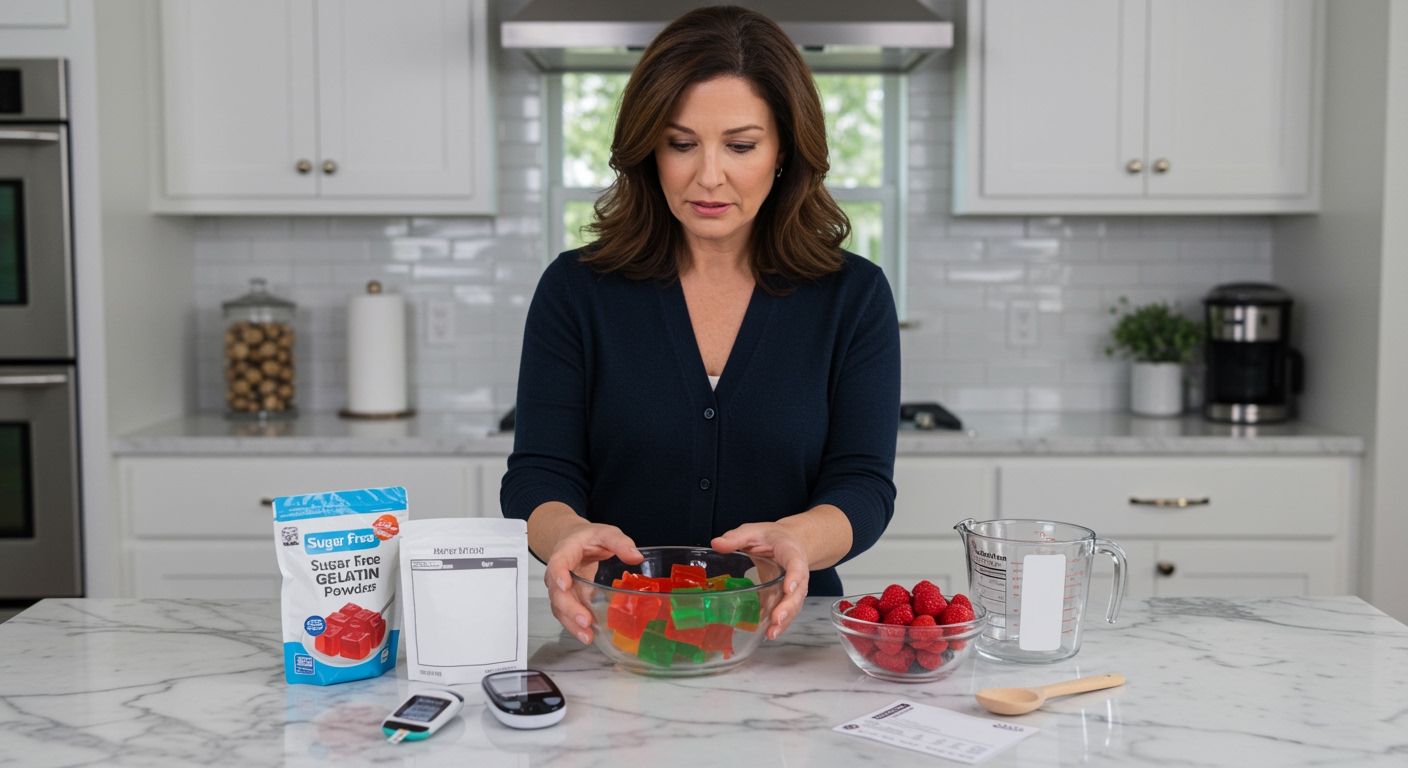✪ Key Takeaway: Regular jello contains high amounts of sugar that can spike blood glucose, but sugar-free versions are generally safe for diabetes.
Introduction
You reach for that colorful cup of jello thinking it seems harmless enough for your diabetes management plan.
Many people with diabetes wonder if this popular gelatin dessert fits into their meal planning because it appears light and refreshing compared to heavy cakes or cookies.
Hi, I am Abdur, your nutrition coach and today I am going to explain exactly how jello affects your blood sugar and share better dessert alternatives for diabetes management.
What Makes Regular Jello Problematic For Diabetes?
Regular jello contains approximately 19 grams of sugar per half-cup serving, which comes primarily from added sugars like high fructose corn syrup or regular sugar.
This amount of concentrated sugar enters your bloodstream rapidly because jello lacks fiber, protein, or healthy fats to slow down absorption.
The glycemic index of regular jello ranges between 60-70, placing it in the high category that can cause significant blood glucose spikes within 15-30 minutes of consumption.
Your pancreas must work overtime to produce enough insulin to handle this sudden sugar rush, which becomes particularly challenging when you have insulin resistance or reduced insulin production.
The artificial colors and flavors in commercial jello products add no nutritional value while potentially contributing to inflammation in some individuals with diabetes.
✪ Fact: One serving of regular jello contains the same amount of sugar as drinking half a can of soda.
How Does Sugar-Free Jello Compare For Blood Sugar Control?
Sugar-free jello uses artificial sweeteners like aspartame, sucralose, or acesulfame potassium instead of regular sugar, containing virtually zero carbohydrates per serving.
These artificial sweeteners do not raise blood glucose levels because your body cannot break them down into glucose molecules that enter your bloodstream.
The glycemic index of sugar-free jello remains at zero, making it a much safer option for maintaining stable blood sugar levels throughout the day.
However, some people experience digestive discomfort from artificial sweeteners, including bloating, gas, or loose stools when consumed in large quantities.
The gelatin protein in sugar-free jello provides about 1-2 grams per serving, which offers minimal nutritional benefit but does not negatively impact blood glucose control.
Research shows that moderate consumption of artificial sweeteners appears safe for most people with diabetes and may help satisfy sweet cravings without derailing blood sugar management.
✪ Pro Tip: Start with small portions of sugar-free jello to test your individual tolerance to artificial sweeteners.
What Are Better Dessert Alternatives For Diabetes Management?
Greek yogurt with fresh berries provides protein, probiotics, and natural sweetness while delivering only 8-12 grams of natural sugars that absorb more slowly than processed alternatives.
Homemade chia seed pudding made with unsweetened almond milk and a small amount of stevia offers fiber, healthy omega-3 fats, and protein that help stabilize blood sugar.
Fresh fruit salad with a sprinkle of cinnamon delivers natural antioxidants, fiber, and vitamins while satisfying sweet cravings without artificial additives.
Dark chocolate with at least 70% cocoa content contains less sugar than milk chocolate and provides beneficial compounds that may improve insulin sensitivity when consumed in small portions.
Frozen grapes or berries create a naturally sweet, refreshing treat that takes longer to eat and provides fiber to slow sugar absorption into your bloodstream.
These alternatives provide actual nutrients your body needs while helping maintain better long-term blood glucose control compared to processed desserts like regular jello.
✪ Note: Always pair sweet treats with protein or healthy fats to minimize blood sugar spikes.
How Should You Monitor Your Individual Response To Jello?
Test your blood glucose levels before eating jello and again 1-2 hours afterward to understand how your body specifically responds to different types and portions.
Keep a food diary that tracks the type of jello, serving size, timing of consumption, and corresponding blood sugar readings to identify patterns over time.
Pay attention to how jello affects your hunger levels and cravings, as some people find that artificial sweeteners trigger increased appetite for more sweet foods.
Consider the timing of jello consumption, as eating it after meals with protein and fiber will produce a smaller blood sugar response than consuming it on an empty stomach.
Work with your healthcare provider to understand how occasional treats like sugar-free jello fit into your overall diabetes management plan and medication timing.
Remember that individual responses vary significantly, so what works for others with diabetes may not produce the same results for your unique metabolism and insulin sensitivity.
✪ Pro Tip: Use a continuous glucose monitor if available to see real-time blood sugar responses to different foods.
The Bottom Line
Regular jello poses significant challenges for diabetes management due to its high sugar content and rapid absorption, while sugar-free versions offer a safer alternative for occasional treats.
Smart food choices come from understanding ingredients, not avoiding entire food categories, and this knowledge empowers you to make decisions that support your long-term health goals.
I would love to hear about your experiences with different dessert options for diabetes management, so please share your questions, success stories, or challenges in the comments section below.
References
At NutritionCrown, we use quality and credible sources to ensure our content is accurate and trustworthy. Below are the sources referenced in creating this article:
- January AI: Glycemic Index of Jelly
- Oregon State University: Glycemic Index and Glycemic Load
- FoodStruct: Gelatin Dessert Nutrition Facts
- PubMed: Artificial Sweeteners and Diabetes Management





